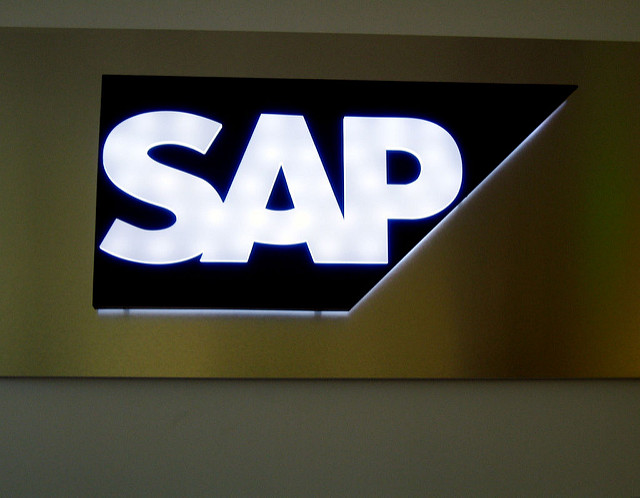What Can SAP Acquire To Meet Its Revenue Shortfall?
Last week, SAP reported results of its second quarter, which were just short of analyst expectations. A major cause for worry was the 5% decline in software license revenue. The disappointing results led to a 7% slide in its stock price.

Photo Credit: Paul Downey/Flickr.com
SAP’s Financials
SAP’s second quarter revenues grew 11% over the year to €6.6 billion ($7.4 billion) compared with the market’s forecast of €6.7 billion. Adjusted profit grew by 11% to €1.8 billion ($2.02 billion), falling just shy of analyst estimates.
During the quarter, Cloud computing revenue increased 40% to €1.7 billion ($1.9 billion). Software license revenues declined 5% to €948 million ($1.06 billion) mainly due to the uncertain business climate and the trade war between US and China. Software support revenue grew 4% to €2.85 billion.
By segment, SAP’s Intelligent Spend Group revenue was up 22% to €786 million. Revenue from the Customer Experience segment which includes the $8 billion acquisition of Qualtrics grew 81% to €365 million. Applications, Technology & Services revenue grew 6% to €5.38 billion.
During the quarter, SAP S/4HANA added 600 customers and now has over 11,500 customers, up 29%. SAP SuccessFactors Employee Central, which is the flagship of SAP’s HCM offering, added more than 180 customers in the quarter and has now more than 3,350 customers globally. Competitive wins included Keolis, Claas, Burger King Brazil, and CONA Services.
The company continues to expect full year 2019 non-IFRS cloud revenue to grow 33% to 39% in the range of €6.7 to €7 billion compared to €5.03 billion in 2018. It expects non-IFRS cloud & software revenue to increase by 8.5%-10% in the range of €22.4 to €22.7 billion. It expects non-IFRS operating profit to be in the range of €7.85 to €8.05 billion.
For 2020, SAP expects €8.6 – €9.1 billion non-IFRS cloud revenue and €28.6 – €29.2 billion($31.87-$32.54 billion) non-IFRS total revenue, which is below the average analyst forecast of $33.05 billion.
By 2023, SAP expects to more than triple non-IFRS cloud revenue from €5.03 billion in 2018. It expects to grow to more than €35 billion in non-IFRS total revenue.
SAP’s Offerings
During the second quarter, SAP launched HANA Cloud Services, which acts as a gateway to this single source of truth, making the data available to people, algorithms and data-driven applications in the cloud. It provides low total cost of ownership (TCO), elasticity, serverless principles, high availability, resilience, and autonomous capabilities.
SAP also introduced new editions of its SAP C/4HANA solutions leveraging Qualtrics CustomerXM. This enables organizations to combine customer feedback and operational data to listen, understand and act in the moment to improve the customer experience.
What can SAP acquire to meet its revenue shortfall?
Last year SAP acquired customer experience management platform provider Qualtrics for $8 billion, AI-powered field service management platform provider Core Systems was acquired for an undisclosed amount, cloud-based Lead to Money (Quote-to-Cash) solutions provider Callidus was acquired for $2.4 billion, and leading conversational AI bot platform Recast for an undisclosed amount.
The last acquisition that SAP made was that of Qualtrics in November 2018. Qualtrics was about to go public before it was acquired. It had revenue of $289.9 million and net income of $2.6 million in 2017.
We have suggested several acquisition prospects for SAP in the past such as enterprise collaboration players Atlassian or SmartSheet, financial software provider BlackLine, enterprise planning services provider Anaplan, inbound marketing software leader Hubspot, CRM players Zendesk or Freshworks, and big data player Splunk. Among them, Zendesk and Splunk would be the best alternatives that can add value to SAP’s bottom-line and strategy.
With the acquisition of Zendesk, SAP could move up in the CRM customer engagement space and increase its value. Zendesk reported revenue of $181.5 million and non-GAAP net income of $5.1 million in the first quarter. Its annual revenue in 2018 was $598.7 million and it is trading at a market cap of $10.03 billion.
Splunk would be an apt fit for SAP’s IoT strategy. Splunk reported revenue of $429 million and non-GAAP income was $3.2 million or $0.02 per share in the first quarter. Its annual revenue in 2018 was $1.8 billion and is trading at a market cap of $20.7 billion.
These acquisitions would help SAP meet its quarterly revenue shortfall of €0.1 billion and also help its meet its 2023 target of tripling its cloud business by 2023.
SAP’s stock is trading at $125.63 with a market capitalization of $154.3 billion. It hit a 52-week high of $140.62 early this month and had fallen to a 52-week low of $94.81 in December last year.



